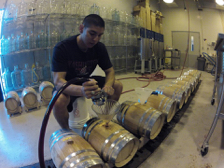Sep 12, 2019Turning up the heat on spoilage yeast that can taint wine
If you’ve ever had a red wine that smelled “off,” like gym socks, Band-Aids, or farmyards, then you’ve likely encountered a wine affected by Brettanomyces bruxellensis(“Brett” for short) – a barrel-dwelling spoilage yeast that can taint the wine, often imparting undesirable aromas and flavors.
While not all Brett is bad (to a few winemakers, it lends desirable flavors), the yeast has vexed vintners for generations because once it infects the barrels, it is next to impossible to eradicate from the vessel wood. Although a definitive “cure” still eludes winemakers, Washington State University’s (WSU) Charles Edwards, a professor in food science, has devised a treatment for the rogue yeast, giving winemakers another way to combat the problem.
Once described by Linda F. Bisson – a former UC, Davis professor – as “a yeast which is nowhere, yet everywhere, all at the same time,” Brett is particularly pernicious because infections can and often do break out suddenly and without warning.
“While there are many approaches to dealing with a wine spoiled by Brett,” Edwards said, “we wanted to know if there are protocols where infected oak barrels can safely be reused.”
Sanitizing methods for treating infected barrels have ranged from the application of chemicals like ozone to the use of “microwaves or high power ultrasonics,” according to Edwards. But these techniques ultimately fall short because Brett can penetrate so deeply into the porous barrel staves. Moreover, there is cost to consider.
“Some of these methods require substantial investment into equipment which may or may not be readily available or financially accessible for many wineries,” Edwards noted.
More conventional approaches to dealing with Brett involve the application of heat in order to reduce microbial populations.
“These methods,” Edwards pointed out, “include filling barrels with heated water– 50 to 70 degrees celsius – or using wand-type systems to apply steam for various amounts of time.” But Edwards wanted to create a more rigorous framework for these management techniques.


With funding from the Washington State Grape and Wine Research Program, Edwards and his team set out to “determine specific conditions for using steam or hot water as means to eliminate B. bruxellensisfrom oak staves.”
To begin, they used 16 oak barrels (American and French) of varied toasting levels, ranging from light to heavy. Next, the team filled the barrels—half of which were infected with Brett – with Cabernet Sauvignon wine, and let them set for 28 weeks. Following the incubation period, Edwards’ team rinsed the vessels, air-dried them for seven days, and sawed barrel staves into 3 X 10 cm rectangles measuring 4mm in thickness. Using these blocks cut from the staves’ midsections, the team applied steam and hot water to determine specific conditions, protocols, and effectiveness of eliminating yeast populations.
“Overall, these studies showed that yeast populations were higher and at greater depths for staves having more extensive contact with infected wine, such as those located toward the bottom or at side areas, as well as those from older barrels.”
The application of steam and/or hot water can be effective against the yeast, Edwards added. But for deeply penetrated infection, the steaming process had to range from nine to 12 minutes to kill the yeast. “That’s a lot of steam.”
Photo at top: Charles Edwards, left, analyzing wines with graduate students. Photos: Washington State University















